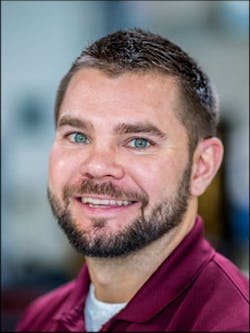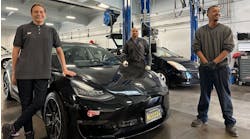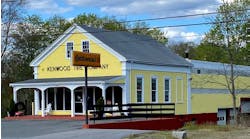On the west side of Lancer Service Inc.’s brick exterior, you’ll find a mural depicting the original shop’s location (and name, OK Service), opened by Jim Thomas in 1977; on the east side: a mural of a long, wavy arrow pointing people to the “Customer Entrance” around the corner.
Then, fittingly, in the middle, there’s Carl Thomas, running Lancer Service in the heart of downtown St. Paul, Minn., trying to live up to his father's legacy and the business's long-standing tradition of treating the customers like royalty.
“We use that ‘every car, every customer’ mentality,” he says. “It’s easy to talk about, and it's easy to think you’re going to do it, but it’s really, really tough to execute.”
Thomas has found that providing the ultimate customer experience is complicated. Customer service skills can be measured by specific metrics, such as a shop's customer service index (CSI) score; Lancer Service is killing it, by the way, at 98 percent.
But how does a shop operator measure employee attitudes? How do you tangibly evaluate shop culture?
“You measure it by making sure customers are happy,” he says. “That's really the key to what we do. It’s the backbone of our entire operation.”
Making sure the customers are happy. It’s such a simple concept, but achieving it at all times is daunting.
So for Thomas, that’s been the focus for three years now, and he found that becoming the go-to shop for downtown St. Paul residents came down to shaping a shop culture that is focused on customer service both inside and outside those walls of Lancer Service.
Downtown Service
Thomas remembers looking up and seeing his father—his face beet red, nostrils flaring.
Thomas, 9 years old at the time, was terrified. Now 32, he laughs about the day he accidentally rammed his go-kart into the brand new gas pump resting outside Jim’s second Lancer Service location.
Lancer Service has moved three times in the downtown area, and has now settled into a small, 5,000-square- foot facility along the Mississippi River. And for each of those moves, Thomas has been at his father’s side. Before his college years, Thomas spent summers earning small paychecks at Lancer Service. He’d only work three days per week, but with Jim, “workdays” were often 12 hours long.
Not that Thomas minded. From visiting the Cedar Lake Speedway in New Richmond, Wis., on weekends to performing light repairs on vehicles with his father, cars were Thomas’ life, and he primed himself for eventually taking over his father’s shop by studying automotive service technology at Century College in White Bear Lake, Minn.
And, as Thomas observed, Jim treated employees in a way that wasn’t conducive to building a customer service–focused shop culture.
An Open Environment
“I have a little greeting scripted out, but past that, you just have to react to what they say. If we get a callback and they say, ‘The sound went away but then it came back,’ I need to respond with, ‘Do you know when it started? Is it the same sound?’ And then you just roll with conversation. I don’t think you can be scripted. You just have to take the phone call as it is, be yourself and go with it.”
DORI MASSAROTTI ADMINISTRATOR
When asked to describe his own personality, Thomas says he has about half of his father’s intensity ... well, maybe “three-fourths.”
Shop administrator Dori Massarotti hardly stifles her laughter when she hears the answer from her desk 10 feet away. Then she chimes in: “You’re better than your dad, but I wouldn’t go lower than two-thirds.”
Massarotti’s addition to the conversation feels natural at Lancer Service. Employees joke and laugh throughout the day, ribbing each other, exchanging inside jokes, sharing their fantasy football strategies, discussing the latest NASCAR race. It’s all indicative of the culture Thomas purposely shaped, creating a small, friendly community of employees essential to providing superlative customer service.
In just a few hours, Massarotti, Thomas, and the eight other employees will break for lunch, all at once, and gather in the main office. On Thursdays, Massarotti will actually bring in a pot of chicken and white bean chili or fire up the grill and provide food for everyone. Meeting every day for lunch, as a team, is crucial, Thomas says.
“I rarely interact with the customer, so my duty on the customer service end is about communicating with the service writer. I need to make sure the service writer has all the information he needs to communicate with them properly. They have to get the real story. A lot can get lost in translation—my job is to make sure the translation goes smoothly.”
JOE SCHOLLA TECHNICIAN
“I know shops will say that that’s ludicrous, that you need to be producing and you can’t take everybody out of the environment for that long,” he says. “It’s something my dad would have never done. But for my team, it’s essential.”
Amongst the joking and laughter, those daily meetings are opportunities for employees to have their say. From “we need a new scan tool” to “I can’t get logged into this system” to “we need to be doing cooling flushes this way,” Thomas wants his employees to function in an environment where opening up about issues is easy.
“At our Christmas party ... I gave a speech about how we had a great group of people that can openly talk about things,” he says. “Before, people were quiet about issues and you couldn’t get to the root cause of it. No matter how hard you dug or what you did, you couldn’t get there. Now it’s just a much more open environment. That makes such a huge difference in the stressload that everybody carries and what everybody does.”
Knowing the Customer
“When I’m trying to figure out how to approach situations or how to sell something or if I’m feeling bad about it being expensive, I remember to treat them like a family member. That helps a lot. For every situation, you have to sit back and think, ‘How would I approach this with my cousin?’ Show people you are concerned, that you care and that you want the best for them.”
JOE GAROFALO SERVICE WRITER
Once Thomas had shaped a more open culture, implementing changes to how employees interacted with customers came easier.
“We need to make sure we’re doing what’s best for the customer, and you can’t do that without knowing your customers’ needs,” Thomas says. “We talk to the customer about what their plans are with the car and ask, ‘What do you think is wrong with it? Have you considered this? What work has been done on it in the past?’ That way, we can get an idea of what we’re going to do with the car.
“For us, that really helps out with the simplicity of the service process. Everything you do from that point on, you know the car, you know the customer, you know what you need to do.”
During Thursday lunches, Thomas reviews specific customer interactions that happened throughout the week. He believes it’s important for every member of the team—even the technicians—to be on the same page to create a uniform focus on the customer experience throughout the repair process.
“If you have a situation where the customer experience didn’t turn out quite the way we wanted it, you look back on that and ask, ‘What happened here?’” he says. “Well, the technician really wasn’t educated on what the customer’s needs were and it changes the way you do communicate the repair order. It changes the way you service a car, and it changes the way you do your inspections.
“Right now we have really good relationships, to where we can open up and cover those things and come to common ground quickly and efficiently and improve the machine.” One last key to Thomas’ management of customer interactions is, well, less management. While everyone follows the same structure, Thomas doesn’t believe in scripts or micro-managing discussions—when it comes down to it, you have to let employees be themselves.
“I think everybody melds into one unit, but still has their own individuality,” he says. “You can force people into doing or saying things they’re not natural with. When people are thinking about what they’re saying as opposed to what they mean to say, it just doesn’t work.”
Beyond the Walls
Thomas reaps the benefits of not only Jim’s managerial teachings, but also the immense clientele database he left behind. But as Jim retired, so have many of Jim’s loyal customers, and a “generational roll-over” is occurring.
Because of the need to obtain new customers in the downtown area, it created a customer service mentality for Thomas that extended beyond the shop walls.
“In the shop, it’s about creating expec- tations for the customer, and I think you should be doing that outside the shop as well,” he says.
In an attempt to market his shop’s superlative customer service, Thomas has established relationships with various downtown businesses. Going through the HR department, he submits PowerPoint presentations about various subjects, such as “Protecting Your Automotive Investment” or “Preparing Your Vehicle
Part of a Community Carl Thomas wants his shop’s customer service to extend outside of its walls and into its St. Paul, Minn., community. If that’s done effectively, he says, all the good his team does in the shop will be on full display. for the Winter,” and then host seminars for employees of the business.
During those meetings—which are sometimes filled with over 100 people— he’s not only providing valuable tips for car maintenance, but he’s also taking the opportunity to lay out exactly what the customer can expect at an auto repair shop.
“When you go in for auto service, what should you expect? I’m getting diagnostic charges, is that normal? How long should it take?” he lists as examples. “And then on the flipside, I have to relay what our expectations of the customer are. I cover the entire process.”
Thomas credits all improvements to enhanced customer interactions, as he’s now training his employees to keep the customer in mind at all times—out at a restaurant or the grocery store or a party, talk about how great Lancer Service is.
And since they like working for Thomas so much, his employees really don’t mind. “Implementation is one thing, but execution is really challenging, and continuously monitoring it is nearly impossible at times,” he says. “Once it becomes a way of doing business, everything goes really smoothly. That’s something we’ve done well for a long time.
“Even though the service industry has changed a lot, people still want to be taken care of. That’s really where we have our niche.”



